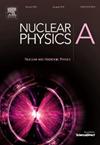α粒子在锌上诱导的核反应:实验和理论评价
IF 2.5
4区 物理与天体物理
Q2 PHYSICS, NUCLEAR
引用次数: 0
摘要
测量了natZn(α,x)67、68、69Ge和66、67、68、70Ga各自阈值能量至20 MeV时的核反应截面。利用叠箔活化技术生成这些反应的激发函数,利用天然钛监测辐照束,利用HpGe探测器测量剩余活度。结合文献实验数据,对本文的研究结果进行了分析,并给出了能达50 MeV的反应的推荐激发函数:NatZn(α,x)67、68Ge、NatZn(α,x)66Ga、64Zn(α,pn)66Ga、64Zn(α,p)67Ga、NatZn(α,x)68Ga和66Zn(α,pn)68Ga。用生成的推荐激发函数计算了这些反应的积分产率。结果表明,NatZn(α,x)67Ge和68Ga反应的积分产率最高,分别为850和450 MBq/µAh。锌的α粒子活化可能是生产67Ge和68Ga的一条有前途的途径,特别是在中等能量的机器上。本文章由计算机程序翻译,如有差异,请以英文原文为准。
Alpha-particles induced nuclear reactions on zinc: Experimental and theoretical evaluation
Cross-sections of the nuclear reactions natZn(α,x)67,68&69Ge and 66,67,68&70Ga were measured from their respective threshold energy up to 20 MeV. The stacked-foil activation technique was used to generate the excitation functions of these reactions utilizing natural titanium for monitoring the irradiation beam, and HpGe detectors for the residual activity measurements. The present results along with the literature experimental data were analyzed to produce recommended excitation functions for the reactions NatZn(α,x)67,68Ge, NatZn(α,x)66Ga, 64Zn(α,pn)66Ga, 64Zn(α,p)67Ga, NatZn(α,x)68Ga, and 66Zn(α,pn)68Ga for energies of up to 50 MeV. The generated recommended excitation functions were used to calculate the integral yield of these reactions. It was observed that the highest integral yield was for the reactions NatZn(α,x)67Ge and 68Ga: 850 and 450 MBq/µAh respectively. The alpha-particle activation of zinc could be a promising route for the production of 67Ge and 68Ga, especially at medium-energy machines.
求助全文
通过发布文献求助,成功后即可免费获取论文全文。
去求助
来源期刊

Nuclear Physics A
物理-物理:核物理
CiteScore
3.60
自引率
7.10%
发文量
113
审稿时长
61 days
期刊介绍:
Nuclear Physics A focuses on the domain of nuclear and hadronic physics and includes the following subsections: Nuclear Structure and Dynamics; Intermediate and High Energy Heavy Ion Physics; Hadronic Physics; Electromagnetic and Weak Interactions; Nuclear Astrophysics. The emphasis is on original research papers. A number of carefully selected and reviewed conference proceedings are published as an integral part of the journal.
 求助内容:
求助内容: 应助结果提醒方式:
应助结果提醒方式:


